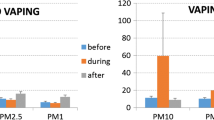Abstract
Objectives: Ethylene oxide is an alkylating agent known to be a directly acting mutagen and carcinogen. This study describes the relationship between workplace ambient air concentrations of ethylene oxide and the concentration of N-2-hydroxyethylvaline in the globin of exposed workers.
Methods: During the sterilization of medical equipment, 12 workers were occupationally exposed to ethylene oxide. Personal and stationary ambient air measurements were carried out to monitor the external exposure. The determination of the protein adducts was based on the N-alkyl-Edman method, introducing a new commercially available dipeptide standard for calibration purposes.
Results: Ethylene oxide concentrations ranging from 0.2 to 8.5 ppm were found in the workplace air. The adduct concentrations ranged from 5,219 to 32,738 pmol N-2-hydroxyethylvaline/g globin in the case of regularly exposed workers (n = 9) and from 518 to 3,321 pmol N-2-hydroxyethylvaline/g globin for three persons with occasional contact with ethylene oxide.
Conclusions: The Deutsche Forschungsgemeinschaft established in 1993 a relationship between the ethylene oxide concentration in ambient air and the amount of N-2-hydroxyethylvaline in human globin. By extrapolation, constant exposure to 1 ppm ethylene oxide should yield approximately 4,000 pmol N-2-hydroxyethylvaline/g globin. The ambient air concentrations of ethylene oxide and the amount of N-2-hydroxyethylvaline determined within the present study confirm this extrapolation in practice. In addition, the determination of adducts based on the use of commercially available dipeptide standards for calibration purposes turned out to be an advantageous alternative to the commonly used protein standards.
Similar content being viewed by others
Author information
Authors and Affiliations
Additional information
Received: 18 February 1997 / Accepted: 9 June 1997
Rights and permissions
About this article
Cite this article
Angerer, J., Bader, M. & Krämer, A. Ambient and biochemical effect monitoring of workers exposed to ethylene oxide. Int Arch Occup Environ Health 71, 14–18 (1998). https://doi.org/10.1007/s004200050244
Issue Date:
DOI: https://doi.org/10.1007/s004200050244




